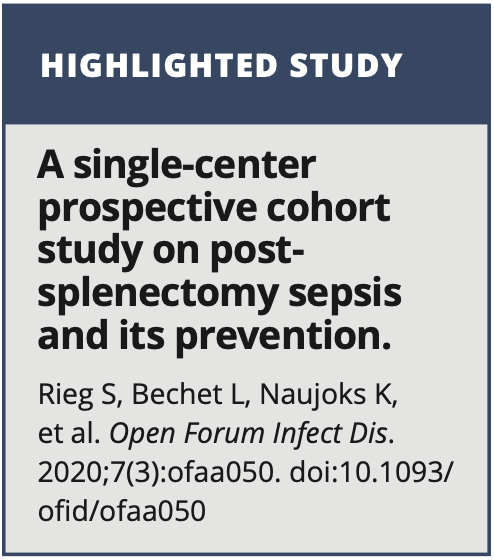Improving Vaccine Uptake in a Cohort of Patients With Asplenia
This is one of the first studies examining the effect of a dedicated postsplenectomy comprehensive clinic.

Impaired splenic function is common and may result from splenectomy, pathologies such as sickle cell disease that result in hyposplenia, and disorders causing splenic engorgement or infiltration.1 Given the spleen’s pivotal role in preventing infection from encapsulated bacteria and intraerythrocytic parasites, impaired splenic function predis­poses patients to overwhelming postsplenectomy infection (OPSI). Specifically, diminished opsonization and phagocytic capacity lead to excessive microbial proliferation relative to clearance, and low-level bacteremia has the potential to rapidly progress.2 The prevalence of an OPSI episode has been esti­mated at 3%, with greater than one-third of these patients suffering 2 or more recurrences.3 The trajectory is often that of rapid decline, with death observed in greater than 50% of cases.3 Thus, prevention of OPSI is critical.
Vaccination remains the cornerstone of OPSI prevention. Clinicians should vacci­nate patients with asplenia against the most common bacterial causes of OPSI, including Streptococcus pneumoniae, Haemophilus influenzae type b (HiB), and Neisseria meningitidis.4 However, despite published guide­lines, completion of the full postsplenectomy vaccine series remains low.5 Possible explanations include provider perception of a complicated vaccine schedule, lack of clarity on who exactly is responsible for giving vaccines, patient vaccine hesitancy, and patients lost to follow-up post splenectomy.
Rieg et al recently examined this issue and the effect of a dedicated outpatient service on vaccine uptake.5 In a prospective cohort study from Germany, the authors recruited and referred patients with asplenia from January 2009 to December 2016 to a comprehensive outpatient clinic. The aims were (1) to evaluate the impact on vacci­nation uptake and (2) to evaluate the incidence and microbiological features of postsplenectomy infections among patients referred to the study clinic. Patients who had undergone splenectomy during the study period, as confirmed by examination of blood smears, were included in the trial. Exclusion criteria included an estimated life expectancy of 3 months or less.
Eligible patients were invited to an outpatient clinic where they were counseled on the risk of infection, prescribed pill-in-pocket preventive anti­biotics, and vaccinated according to guideline-based recommendations. During this visit, clinicians recorded demographic variables, comorbidities, vaccination status, and hospitalizations for postsple­nectomy infections. Additional follow-up occurred at 3 and 12 months, as well as at the conclusion of the study.
The study enrolled 459 patients, with the most common indications for splenectomy being malig­nancy, trauma, therapeutic splenectomy, benign abdominal tumors, and functional hypoasplenia.
Among study participants, 71% received at least a single dose of a pneumococcal vaccine, 52% received at least a single dose of a meningococcal vaccine, and 69% received HiB vaccination within 3 months of splenectomy. Only 17% of patients who underwent elective splenectomy had been vaccinated within 2 weeks of surgery. Vaccination uptake increased during the study, with cumu­lative pneumococcal vaccination uptake reaching 90%.
Ninety-three percent of the cohort had a minimum of 3 months of follow-up, and the median duration of follow-up was 2.9 years. Twenty-three percent of the cohort required hospitalization for postsplenectomy infec­tion, and 4% met criteria for OPSI. Twenty percent of study participants died after a median of 1.5 years, with the cause of death being infection related in 10% and related to comorbid illness (59%) or unknown factors (32%) in the remainder.
The most common sites of severe sepsis/septic shock were the lower respiratory tract (32%) and the urinary tract (23%), with primary bacteremia representing 5%. The median time to first infection from splenectomy was 3.1 years. A microbiologic diagnosis was established in 43% of patients during follow-up, with the most common pathogens being Escherichia coli and Klebsiella spp. The authors observed only 1 episode of sepsis due to S pneu­moniae, in a patient who had been vaccinated with pneu­mococcal polysaccharide vaccine 14 months prior. This was in contrast with 22 episodes of OPSI in the cohort prior to study entry, in which primary bacteremia represented the majority of infections, at 32%. S pneumoniae was the caus­ative pathogen among 36% of episodes, with 87% of these patients never having received pneumococcal vaccination prior to study enrollment.
This is one of the first studies examining the effect of a dedicated postsplenectomy comprehensive clinic. It also provides updated data regarding the microbiology and clinical features of postsplenectomy sepsis in the era of the 13-valent pneumococcal conjugate vaccine. Prior to study entry, the authors found poor baseline rates of vaccination against pneumococcus (27%), meningococcus (17%), and HiB (18%). The authors significantly increased pneumococcal vaccination by creating a dedicated clinic that provided specialized postsplenectomy care, with a cumulative pneumococcal vaccination rate of 90% and comparable rates for meningococcus and HiB. The authors observed that the microbiology of postsplenec­tomy sepsis largely mirrored that of the general public, with significantly fewer episodes due to pneumococcal disease. This study underscores the critical importance of improving vaccination rates in this vulnerable population. Similar asplenic-focused clinics elsewhere may further decrease morbidity and mortality in this population.
Bullis is an infectious diseases fellow at the University of Vermont Medical Center in Burlington.
Hale is an infectious diseases physician at the University of Vermont Medical Center and an assistant professor of medicine at Larner College of Medicine at the University of Vermont.
References:
- Di Sabatino A, Carsetti R, Corazza GR. Post-splenectomy and hyposplenic states. Lancet. 2011;378(9785):86-97. doi:10.1016/S0140-6736(10)61493-6
- Borges da Silva H, Fonseca R, Pereira RM, Cassado Ados A, Álvarez JM, D’Império Lima MR. Splenic macrophage subsets and their function during blood-borne infections. Front Immunol. 2015;6:480. doi:10.3389/fimmu.2015.00480
- Bennett J, Dolin R, Blaser MJ. Mandell, Douglas, and Bennett’s Principles and Practice of Infectious Diseases. Elsevier; 2019.
- Rubin LG, Levin MJ, Ljungman P, et al. 2013 IDSA clinical practice guideline for vaccination of the immunocompromised host. Clin Infect Dis. 2014;58(3):e44-100. doi:10.1093/cid/cit684
- Rieg S, Bechet L, Naujoks K, et al. A single-center prospective cohort study on postsplenectomy sepsis and its prevention. Open Forum Infect Dis. 2020;7(3):ofaa050. doi:10.1093/ofid/ofaa050

